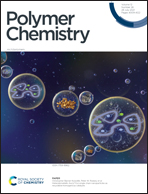Synthesis and self-aggregated nanostructures of hydrogen-bonding polydimethylsiloxane†
Abstract
Gaining control over assembled nanostructures is an important aspect in nanotechnology and materials. Compared to specific directional interactions, self-aggregation of clusters driven by the forces of hydrogen-bonding (H-bonding) polymers, constitute a novel and simple strategy toward the tuning of nanostructures. In this work, we first demonstrate the precise synthesis of tailored polydimethylsiloxane (PDMS) at their α-ends bearing a series of H-bonding moieties (e.g., barbiturate (Ba), 2,4,6-triaminopyrimidine (TAP) and Hamilton wedge (HW)), using a robust copper(I)-catalyzed azide–alkyne cycloaddition (CuAAC) reaction. Complete end group functionalization is proven by NMR and matrix-assisted laser desorption/ionization time of flight mass spectrometry (MALDI-MS) methods. Self-aggregated H-bonds are indeed formed in the melt state from the obtained H-bonding PDMS, evidenced by temperature dependent solid-state 1H MAS NMR. Subsequent small angle X-ray scattering (SAXS) studies unveil a profound picture of nanostructures, including lamellae (LAM), hexagonally packed cylinders (HPC), body-centered cubic spheres (BCC) and disordered micelles (DIM). We found that these morphologies are influenced by the molecular weight of the PDMS (1200, 5800 and 11 300 g mol−1), as well as by the nature of H-bonding moieties (e.g., Ba, TAP, HW), proving that both the immiscibility parameter and the volume fraction between nonpolar PDMS and polar H-bonding moieties determine the final structures. Moreover, we also demonstrate a thermally reversible order–disorder transition (ODT) in the observed nanostructures, induced by the H-bonding self-aggregation as observed by temperature-dependent SAXS investigations. The strategy to engineer nanostructures to form the cluster and aggregation of H-bonding polymers is significant, providing new insights to control the supramolecular polymer chain organization and phase separation effects.



 Please wait while we load your content...
Please wait while we load your content...